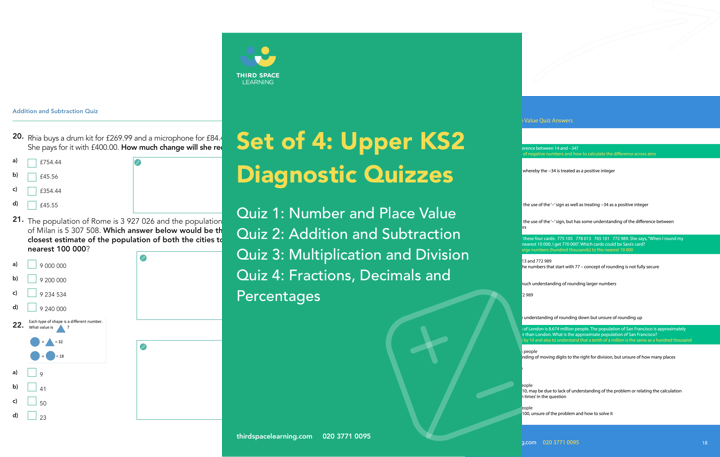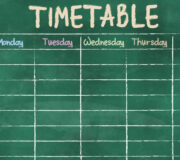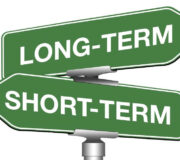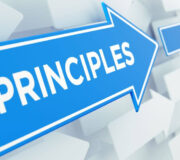25 Assessment For Learning Examples To Use With Your Students Today
Assessment for learning examples are the strategies and activities that teachers employ during the learning process to support student learning. In this blog, we’ve listed 25 assessment for learning examples that you can use and adapt in your classroom today.
Assessment for learning, also known as ‘AFL’ or formative assessment, is an established practice and use of assessment in teaching. It involves ongoing assessments that are used to inform and adjust instruction.
In contrast, assessment of learning or summative assessment is typically administered at the end of a unit of work to evaluate the student’s overall achievement against a predetermined standard.
Good understanding of the assessment process and the types of assessment, alongside effective feedback (both oral and written feedback) are key to ensuring success with both student progress and student achievement and should be ingrained within classroom practice. To help you with this, we have put together a collection of 25 assessment for learning examples for you to try out and adapt for your classroom.
Everything starts with the framework for learning
In order for effective assessment for learning to take place, it is important to first develop explicit learning intentions and success criteria that are shared with students and teachers.
That’s why every Third Space Learning online one to one maths lesson starts with a clear learning intention on the cover slide.
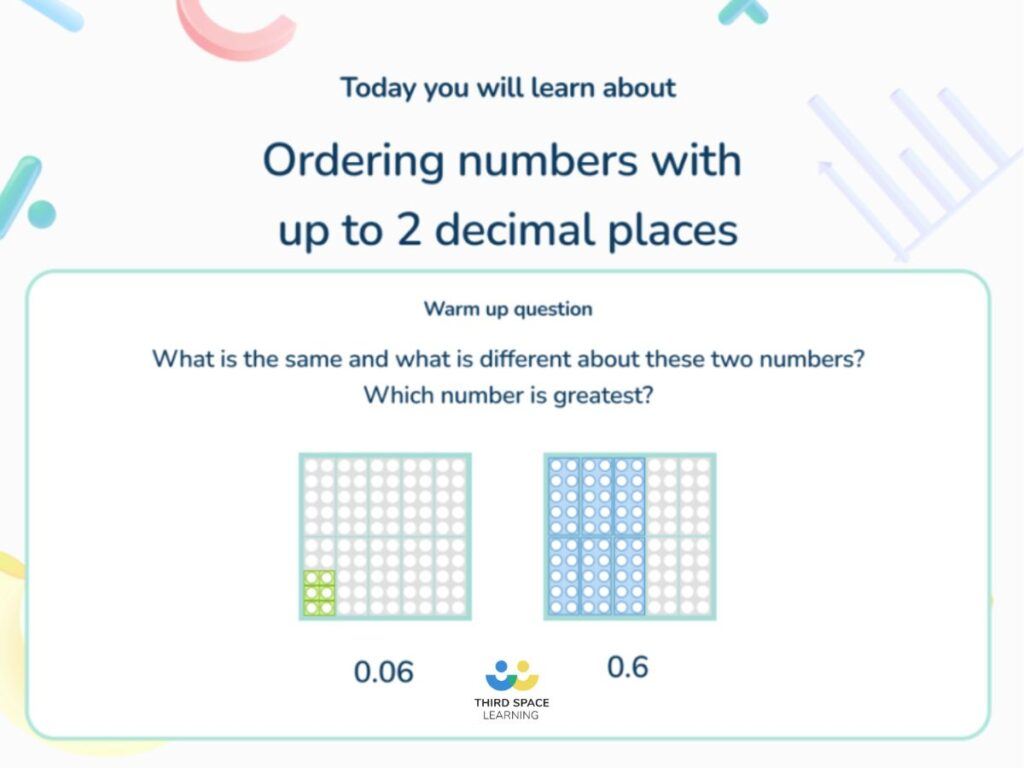
Explicit learning intentions and criteria for success provide teachers and children with a clear framework for making judgements about whether successful learning has taken place. These can be written by the teacher and shared with the class, or even better if learning goals can be created in collaboration with the children. Once these are established, assessment for learning can take place.
Here are Third Space Learning, after pupils’ tutoring sessions, they complete post-session questions. The post-session questions relate specifically to the learning intention of their session that day.
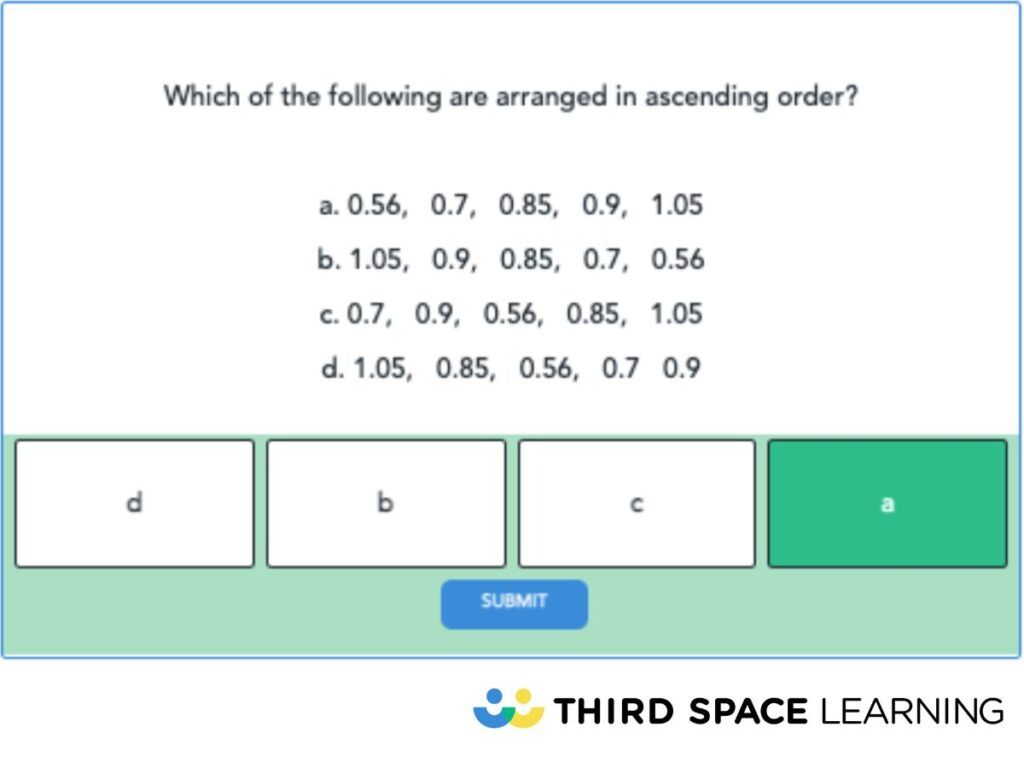
Classroom examples of assessment for learning
Assessment for learning can be split into three overall categories:
- Teacher assessment
- Self assessment
- Peer assessment
Below, you can learn more about each category, when each category is best employed and examples for each. The best teachers will use a range of assessment for learning strategies across these three categories in their teaching practice.
Read more: Formative and Summative Assessments and What is assessment for learning
Diagnostic Year 6 Maths Quizzes
Download our free resource on diagnostic year 6 maths quizzes that you can use in your classroom.
Download Free Now!Teacher assessment
Teacher assessment should be used during all stages of the lesson, whether it be as a diagnostic assessment to inform the teacher where the pupils are at the start, how they are coping at a certain point during the lesson or to assess understanding at the end of the lesson.
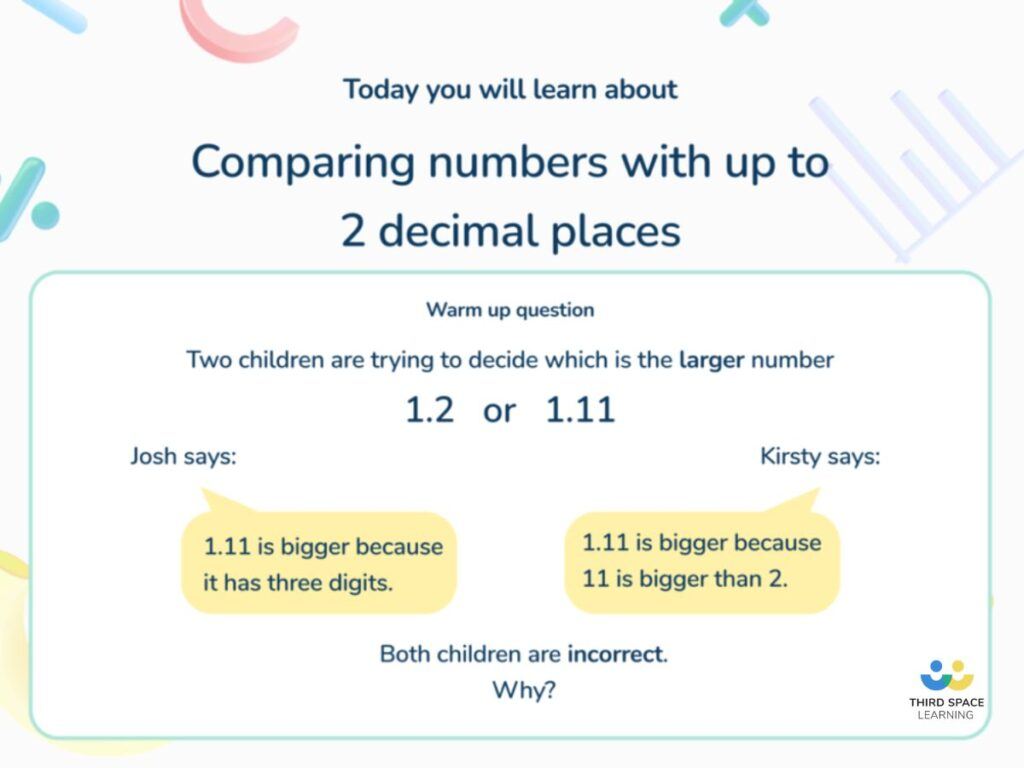
In Third Space Learning’s online one to one maths tutoring, pupils complete a warm up question at the start of the lesson. Tutors use this formative assessment to understand possible misconceptions or needs and adjust their approach accordingly. This means that time is used efficiently and ensures the session is personalised to the pupils’ learning needs.
The one to one nature of our programmes means that tutors are able to easily adapt their teaching throughout the session to the pupil’s needs, addressing gaps and misconceptions as they come up.
It’s important that teachers develop positive learning environments where pupils feel comfortable engaging in classroom assessment, answering questions and discussing their ideas in groups. This is because observation and questioning are the main methods here. For questioning to be beneficial, it needs to be strategic to enable teachers to identify and correct any misunderstandings or gaps in knowledge.
With any form of questioning within the lesson, it is important to ensure both open and closed questions are used. Closed questioning only provides children with the opportunity to recall their knowledge and understanding, whereas open questions encourage children to think and recall more information.
Examples of questioning sentence starters include:
- Can you explain……?
- Is X important?
- How would you….?
- Why does…..?
- What if…..?
Teachers need to use different strategies to ensure they are eliciting as much information from the learner as possible and have a full awareness of student understanding across the room. Helpful strategies include:
- Using the word ‘might’ to encourage pupils to think more carefully and explore possible answers. For example: ‘why might that have happened?’
- Prompting children to give more information, e.g. ‘Persuade me….’, ‘why do you think that….?’
- Ask children to build on each others’ answers, e.g. ‘Mason, what do you think about the answer Chloe has given?
Read more: Hinge questions
Assessment for learning examples: Teacher assessment
1. Whole-class questioning
Whole-class questioning is a quick way for the teacher to gather information on the level of understanding of the class a whole.
The key here is to ensure that children are given enough time to think and formulate their response.
Whole class questioning can be used at different points of a lesson. For example, effective questioning at the start to provide a quick picture of where the children are, or mid-lesson to give the chance for maths misconceptions to be addressed. Alternatively, this can be used to assess understanding at the end.
However, as with all examples in this list, it is important to not always rely on this assessment for learning example as it may not be best suited for many learners and you may only hear from the more confident learners in a class.
2. Round the room questioning
This method of assessing involves the teacher circulating round the room, questioning individual or small groups of children.
The benefit of this is that it enables the teacher to strategically target questions at specific children, quickly identifying and addressing any misconceptions as they arise. Additionally, it provides an opportunity for praise and encouragement. It is a helpful mid-lesson activity to carry out when children are working independently or in small groups.
3. Observing
Whilst questioning is an excellent way for a teacher to gather information on the level of understanding in a class, another method is to simply observe what is happening in the room at any given moment.
This is something that doesn’t always happen as often as it could because teachers often feel they need to be actively asking questions and encouraging children. Observing can be an equally powerful way to do this.
The teacher observes individuals or small groups of children completing an activity or task and makes notes (mentally or written) on what they observe.
This is a useful form of assessment at any point during the lesson. For example, if the maths lesson begins with a challenge, the teacher can circulate around the room, observe what is happening, but also listen to any discussions taking place. The teacher can quickly gather information to adjust their teaching, move on or address misconceptions as needed.
4. Class quizzes and polls
Quizzes and polls are similar ways to assess pupils’ knowledge and understanding. Polls collect choices or opinions, with no right or wrong answers, whilst quizzes provide the opportunity for students to give right or wrong answers. They can be carried out traditionally, using written answers, or be technology-assisted, using computers, tablets or iPads. You can use apps such as Padlet and Kahoot.
Using quizzes and polls at the start of a lesson can be useful for establishing pupils’ prior/existing knowledge. At the end of the lesson, they can be used to determine what has been learnt and any gaps in understanding.
5. Colour coded lollipop sticks
Each child in the class has their name written on the lollipop stick. These can be colour coded by ability level, to help the teacher direct appropriate, targeted questions (without the children being aware of this).
You can also use online tools if you don’t have any lollipop sticks to hand. This has the added benefit of proving to students that it’s bias-free!
This is a useful strategy to be used at any stage of the lesson.
6. Think, pair, share
With this strategy, the teacher asks a question and the students think about, or write down their ideas. They then share this with a partner before coming back together as a whole class to discuss.
Teachers are able to make observations at both the pair discussion and the ‘share’ stage. This method of assessment is useful throughout the lesson: at the beginning, to establish prior knowledge, during the teacher input and at the end of the lesson to assess level of understanding once the concept has been taught.
7. Mini whiteboards
Mini whiteboards are a popular way for teachers to assess understanding at the beginning of the lesson and during the main teaching input. They can be particularly valuable in maths lessons.
Students write their answers and hold up for the teacher to see. The teacher is able to quickly assess the level of understanding across the whole class and can identify misconceptions and gaps, without necessarily drawing the attention of the whole class to any children who may be struggling. Misconceptions can be quickly addressed and children who need additional support can be identified.
8. ABCD cards
Children are given 4 cards (either individually or as a pair/group) with one letter (A, B, C and D) on each card. Ask all the children a question and provide them with four possible answers. Children hold up a card matching the answer they have chosen.
Similar to mini whiteboards, this is a quick and easy way for the teacher to assess the whole class.
9. Round robin
This activity involves the students working in groups. On a large piece of paper, the group writes their answer to a specific question. This is then passed on to the next group of students, who add their answer to the poster.
Once all the groups have contributed to the poster, the teacher leads a whole class discussion exploring the answers given.
This is a useful activity that can be administered at the start or at the end of a lesson.
10. Meet and greet
With meet and greet, the children move around the room until the teacher gives a signal. Pupils then stop and find a partner. The signal could be anything – a bell, a clap, or stopping the music.
Children discuss their answer to their partner before moving on when the teacher signals again. The teacher is able to observe and listen to discussions as the children move around the room. This is a great activity for younger pupils.
11. Making circles
This example is similar to meet and greet but is a good way to ensure paired discussion takes place between different pairs of children.
Split the class in half, with one half of the children forming a circle and facing outwards. The rest of the class then find a partner from the circle and stand with them. The children work together to answer the question, before the outer circle moves round one place and the discussion can take place, but with a new partner.
Pairs can be engineered to be of mixed ability by strategically placing children in the inner circle.
Self assessment
While teacher assessment is important, pupils’ self-assessment is a key element of the assessment for learning process.
Pupils have the opportunity to reflect upon their prior knowledge at the start of a topic and evaluate and assess their own learning throughout the lesson. Students also benefit from having an awareness of their own progress, where they’ve come from and where they are going to. This can help to develop students’ metacognitive skills and a growth mindset.
There are a range of strategies teachers can adopt to encourage relevant and meaningful self-assessment within their classrooms. Our pupils have the opportunity to reflect on their learning during sessions and at the end of sessions.
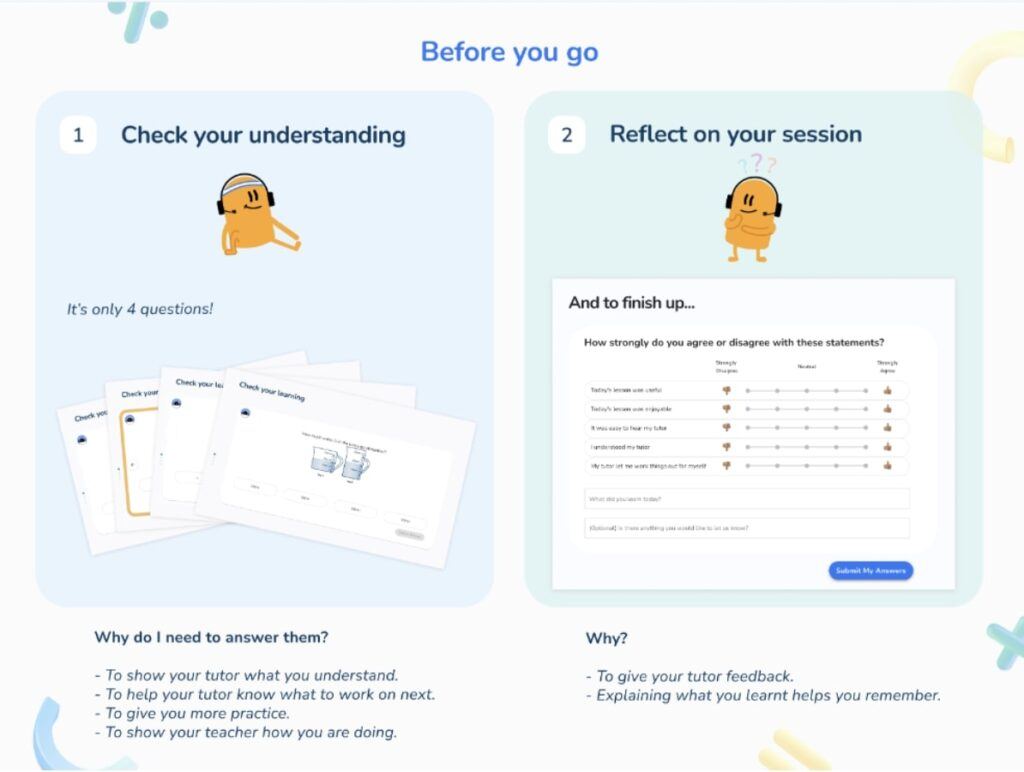
Assessment for learning examples: Self assessment
12. Traffic lights
Children are given a red, amber and green card which they use as a visual way of sharing their level of confidence with the teacher. At any point, they can put down a card, with red showing they don’t understand and need more help, amber to show they partially understand, but may need some support and green to show they are confident and fully understand what they are doing.
This is a useful activity for pupils during the independent stages of a lesson and could support shy students who may not usually ask for help. It can also be used at the end of the lesson to encourage pupils to reflect on their learning. To encourage pupils to reflect on their progress, you could ask pupils to RAG-rate their understanding of a learning objective at the start and end of the lesson.
13. Thumbs up/down
This is similar to traffic lights and is a very quick way for children to self-assess at any stage of the lesson.
Children simply hold their thumbs up to show they are confident, holding thumbs horizontally shows they feel they partially understand and thumbs down shows they feel they need more work/support.
This is ideally carried out with eyes closed to minimise the risk of children being influenced by the children around them. It enables them to show if they are lacking confidence without worrying what others think.
14. Draw a square / highlight the learning objective
This is another similar strategy to the traffic light cards and thumbs up and down. It is used at the end of the lesson for children to quickly and visually show their level of understanding or confidence.
They either draw a box and colour it using pink, orange or green highlighter pen, or they highlight the learning objective at the top of the page. Green is used to show they are confident and feel they understanding, orange to show they feel they have some understanding and pink is used to show they
15. Draw a face
This is a similar strategy to the traffic light system, but more suited to children in Key Stage 1.
At the end of the lesson, children are asked to share how confident they are feeling about what they have learnt that lesson. If they feel they understand, they draw a smiley face, if they only partly understand, they draw a face with a straight lined mouth and if they don’t feel they understand, they draw a happy face.
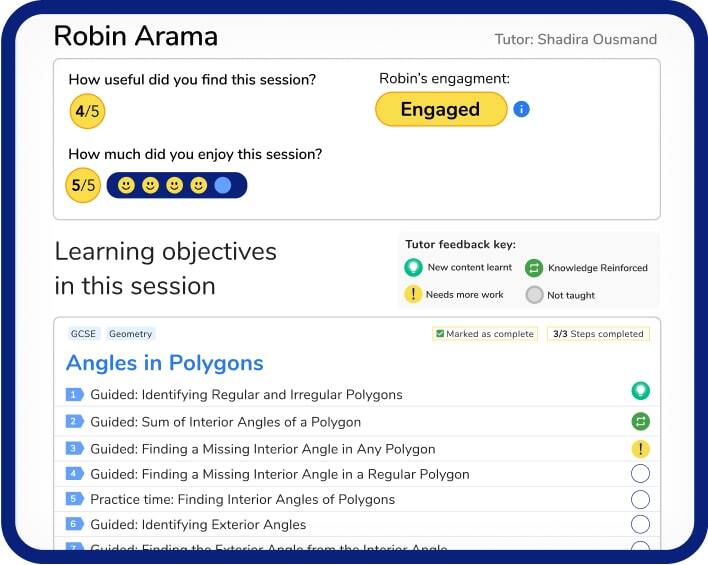
Pupils who complete a one-to-one online tutoring session with Third Space Learning complete post-session questions to record their progress and understanding. Pupils are asked to reflect on their learning and their enjoyment of the session. This helps develop pupils’ metacognitive skills as they engage in the important skill of reflection and connect their session with their learning goals.
16. 3-2-1 countdown
This is a useful self assessment activity for children to complete at the end of a lesson or topic. They can either record their answers on paper or give them orally to the three statements below:
- 3 things you didn’t know before
- 2 things that surprised you about this topic
- 1 thing you want to start doing with what you’ve learned
17. Write a summary sentence
This can be used at the start or the end of the lesson. Children are asked to write a sentence to summarise what they know, before the lesson begins or at the end of the lesson to share what they have learnt during the lesson.
18. Post its
Post-it notes can be used by pupils individually or in pairs or groups. Children can answer questions at the start of the lesson to encourage them to think about their level of understanding at that stage. You can pose questions such as:
- What do I know already?
- What do I want to know?
Alternatively, post-its are a great way of assessing at the end of the lesson as an exit ticket, using questions such as:
- What have I learnt?
- What did I find difficult/hard?
19. KWL – Know, want to know, learnt
This form of self-assessment spans the topic, partly completed at the start and partly completed at the end. Children split their page into three columns with the headings:
- What I know
- What I want to know
- What I have learnt
The first two columns are completed at the start of the lesson or topic, with the final column being completed once the topic or lesson has been completed.
20. Not yet clear
At the end of a topic or lesson, ask the children to think about anything they don’t understand or aren’t clear about and write them down.
These can be shared anonymously with the whole class who can work together to discuss the points and ensure all children are clear. This is beneficial for both the children who need the extra help and for the children who are confident, but still benefit from sharing their own knowledge.
This is particularly useful in maths, when children may have used different strategies to achieve the same outcome. This activity provides a good opportunity to share and discuss these different strategies.
21. Most…..thing
At the end of a lesson or topic, children write down their answer to a ‘most….. thing’ question. This could be to say, for example what they found:
- most challenging
- most interesting,
- most useful
- most surprising
about that lesson or topic.
22. Admit and exit tickets
Admit and exit tickets are small pieces of paper or card that students fill in at the start or end of the lesson. If you have the tech, you can also do this online using tools such as Jamboard.
Admit tickets are completed by children at the beginning of the lessons. Students might respond to questions about homework, the lesson taught the day before, or their knowledge beginning a new topic.
Exit tickets are completed at the end of the lesson or before they leave the classroom. It could be a record of what they feel they have learnt during that lesson or a question based on their learning from that lesson.
Peer assessment
For peer assessment and peer feedback to be successful, it is essential that all parties are clear on the learning outcome.
This form of assessment relies on interaction between children, so it is important that all pupils feel comfortable, not only providing their assessment of another child’s work, but also having their own work assessed.
The teacher can support this through clear modelling of the process, such as role playing with a piece of fictional work.
Assessment for learning examples: Peer assessment
23. Two stars and a wish
This is a simple way to encourage peer assessment and to provide children with a structure. Children look at the work of another child and write down two stars – two things they felt were good with that piece of work and one wish – one thing they felt could be improved.
24. Peer checking of work
Students read each other’s written work and look for key points, such as spelling mistakes, use of adjectives/ adverbs for description or the use of conjunctions to extend sentences. In maths, they may look at accuracy in pupils’ use of formal methods or diagrams.
Children should be encouraged to feedback on specific points, again focusing on the positives, in addition to areas to improve. Modelling is key to avoiding hurtful language or comments.
25. Peer assessment card
Children are provided with a peer assessment card with a list of targets for them to assess. For example, the focus could be on punctuation and checking for capital letters, full stops, question marks, exclamation marks, apostrophes and speech marks.
For each focus on the card, children RAG rate it (red, amber or green) using coloured pens or pencils, to show how close they feel the person they are assessing is to each target. This self-assessment tool simplifies the feedback process so may be better suited to younger learners.
Assessment for learning can be incorporated into any stage of the lesson. Some strategies can be planned in advance and included within a lesson plan, while other strategies can be used on a more ad hoc basis, as and when appropriate.
What is common with all of these strategies is the opportunity they provide for children to play an active role in their learning. And key to the success of all of these assessment for learning examples is how teachers use the data they gather to adjust their teaching and address misconceptions to close gaps in pupils’ learning.
FAQs on assessment for learning examples
AFL is the strategic use of ongoing assessments to gather information about student learning. As a result, teachers can adjust their instruction. Examples of AFL include whole class questioning, exit tickets and traffic light self-assessment.
AFL strategies can be teacher assessment, self assessment and peer assessment.
AFL requires students to be more active in their learning. They may be answering questions, discussing in groups or whole class discussions, peer assessing or self assessing their work.
DO YOU HAVE STUDENTS WHO NEED MORE SUPPORT IN MATHS?
Every week Third Space Learning’s maths specialist tutors support thousands of students across hundreds of schools with weekly maths intervention programmes designed to plug gaps and boost progress.
Since 2013 these personalised one to one lessons have helped over 150,000 primary and secondary students become more confident, able mathematicians.
Learn about the diagnostic assessment or request a personalised quote for your school to speak to us about your school’s needs and how we can help.

